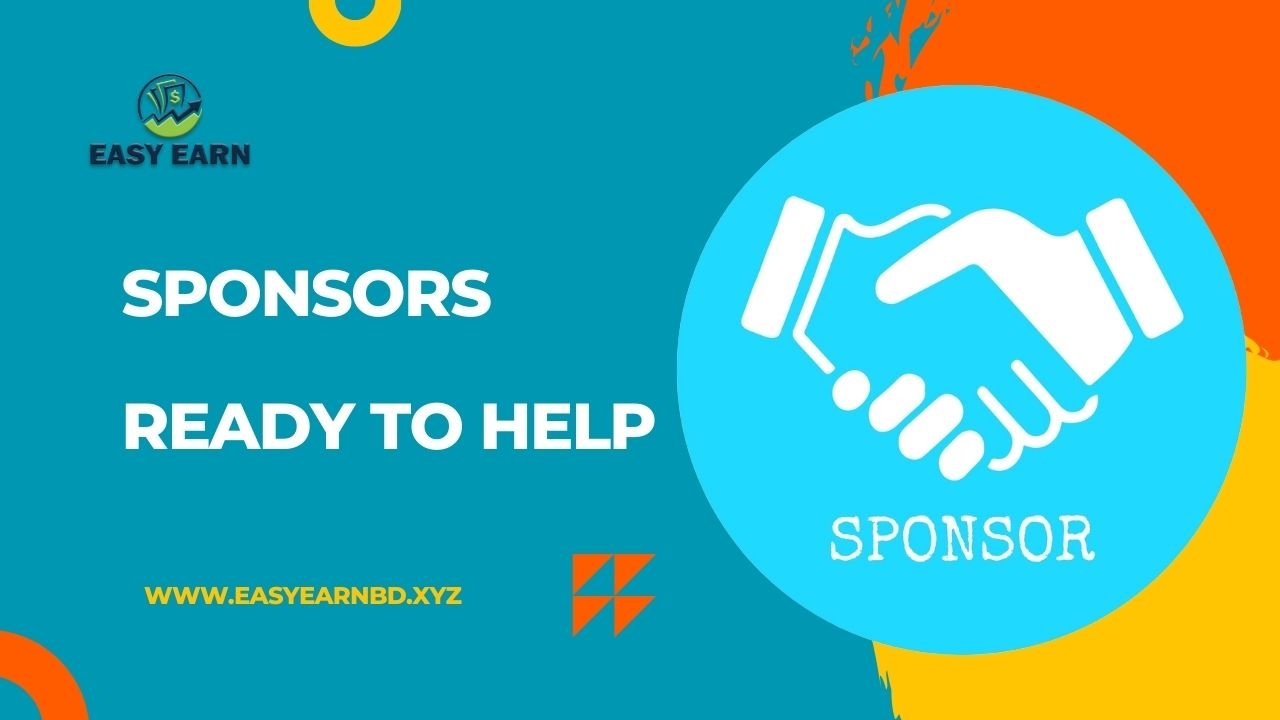Sponsors can be a lifeline for many initiatives. They provide essential support and resources.
Are you planning an event or launching a new project? Finding the right sponsors can make a huge difference. Sponsors offer not just financial aid, but also credibility and visibility. They help bring your vision to life. The good news?
Many sponsors are eager and ready to help. They want to invest in innovative ideas and community-driven projects. In this post, we’ll explore why sponsors are important and how they can support your goals. From local businesses to large corporations, there’s a wide range of potential sponsors out there. Ready to discover how sponsors can assist your journey? Let’s dive in and learn more about the support they can provide.
You May Also Like:

Types Of Sponsors
Sponsors play a crucial role in supporting various events and initiatives. They provide the necessary funds and resources to make projects successful. There are different types of sponsors, each with its own unique benefits. Understanding these types can help in identifying potential sponsors for your needs.
Corporate Sponsors
Corporate sponsors are businesses that provide financial support or other resources. They do this in exchange for advertising and brand exposure. These sponsors often have significant budgets allocated for marketing purposes. This makes them ideal partners for large events or initiatives.
Some common benefits of corporate sponsorship include:
- Financial support: Corporations can offer substantial funds.
- Brand recognition: They help boost the visibility of your event.
- Resources: Access to equipment, venues, and other assets.
Many corporations sponsor events to reach their target audience. They often look for opportunities that align with their brand values. This alignment ensures mutual benefit for both parties.
Examples of corporate sponsors include:
| Industry | Example Companies |
|---|---|
| Technology | Apple, Google, Microsoft |
| Automotive | Toyota, Ford, BMW |
| Food and Beverage | Coca-Cola, Pepsi, Nestle |
Building a relationship with corporate sponsors can open many doors. It is important to understand their goals and how they align with your event.
Nonprofit Sponsors
Nonprofit sponsors are organizations that focus on social causes. They support events and projects that align with their mission. These sponsors often have limited budgets compared to corporate sponsors. Yet, their support can be invaluable in other ways.
Benefits of nonprofit sponsorship include:
- Shared mission: Aligning with a cause can add value to your event.
- Community support: Nonprofits often have strong community ties.
- Credibility: Association with a nonprofit can enhance your reputation.
Nonprofit sponsors may provide volunteers, promotional support, and other resources. They often look for opportunities that further their mission and values. Collaborating with nonprofit sponsors can also help in reaching a wider audience.
Examples of nonprofit sponsors include:
| Type | Example Organizations |
|---|---|
| Environmental | Greenpeace, WWF, Sierra Club |
| Health | Red Cross, American Cancer Society, WHO |
| Education | UNICEF, Teach For America, Room to Read |
Partnering with nonprofit sponsors can be a rewarding experience. It is crucial to ensure that your event aligns with their mission. This alignment can lead to a successful and meaningful collaboration.

Benefits Of Sponsorship
Sponsors play a vital role in helping organizations and events succeed. They provide financial support, resources, and expertise. This relationship is beneficial for both sponsors and recipients. The benefits of sponsorship are many. Let’s explore how sponsors can help with brand exposure and community support.
Brand Exposure
Sponsorship offers a great chance for brand exposure. When a company sponsors an event, its logo and name appear in various places. This includes banners, brochures, and social media.
This exposure helps the brand reach a wider audience. People attending the event see the sponsor’s name and learn about their products or services. This kind of visibility is valuable.
Here are some ways sponsorship can enhance brand exposure:
- Event branding: Logos on event materials
- Social media mentions: Posts and tags on platforms
- Media coverage: News articles and TV spots
- Product displays: Showcasing products at events
These methods help to increase brand recognition. People start to associate the brand with positive experiences. This can lead to more trust and loyalty from customers.
Community Support
Sponsorship also strengthens community support. When companies sponsor local events, they show they care about the community. This support can be in the form of money, products, or volunteer time.
Communities appreciate this help. It makes people feel valued and supported. This leads to a positive image for the company.
Here are some ways companies can support their communities through sponsorship:
- Funding local events: Festivals, sports teams, and charity runs
- Providing resources: Equipment, services, or expertise
- Employee involvement: Encouraging staff to volunteer
- Educational programs: Scholarships and training sessions
These efforts help to build strong relationships between companies and their communities. People are more likely to support businesses that give back. This leads to a loyal customer base and a positive reputation.
Finding The Right Sponsor
Finding the right sponsor can be a crucial step for any project or event. Sponsors provide the needed financial support, resources, and credibility. They help turn ideas into reality. Understanding how to find and align with the right sponsor is essential. This blog will guide you through the process.
Researching Potential Sponsors
Identifying potential sponsors is the first step. It requires thorough research and understanding. It’s important to look for companies or individuals that have a history of sponsoring similar projects. This increases the chances of them being interested in your project.
Here are some key points to consider:
- Industry: Look for sponsors in the same industry as your project.
- Company Size: Larger companies may have more resources to offer.
- Previous Sponsorships: Check if they have sponsored similar events before.
- Contact Information: Gather contact details of potential sponsors.
Additionally, it’s helpful to create a list of potential sponsors. This will keep your search organized and focused. Here’s an example of how you can structure this information:
| Company Name | Industry | Previous Sponsorships | Contact Information |
|---|---|---|---|
| Company A | Technology | Yes | contact@companya.com |
| Company B | Healthcare | No | contact@companyb.com |
Detailed research helps in identifying the best potential sponsors. It also prepares you for the next step of reaching out and making a connection.
Aligning Values
After identifying potential sponsors, it’s important to ensure that their values align with yours. This alignment is crucial for a successful partnership. Sponsors are more likely to support projects that reflect their own values and mission.
Consider the following factors:
- Mission Statement: Compare your project’s mission with that of the sponsor.
- Corporate Social Responsibility (CSR): Check if your project supports their CSR goals.
- Brand Image: Ensure that your project enhances their brand image.
- Target Audience: Match your audience with the sponsor’s target audience.
For example, if your project focuses on environmental sustainability, look for sponsors that prioritize green initiatives. This shared value can form a strong foundation for the partnership.
Aligning values not only increases the chances of securing sponsorship but also ensures a harmonious collaboration. It helps in creating a mutually beneficial relationship that can last beyond the initial project.
Crafting A Proposal
Securing sponsorship can greatly boost your projects. Whether for events, charities, or personal ventures, sponsors provide essential support. Crafting a convincing proposal is key. This guide will help you with the process.
You May Also Like:

Key Elements
Creating a strong proposal involves several key elements. Each must be carefully crafted to attract sponsors.
- Introduction: Start with a brief introduction. Mention who you are and your project.
- Project Details: Clearly explain what your project is about. Include objectives and goals.
- Target Audience: Define your audience. Show why they matter to the sponsor.
- Benefits to Sponsor: Highlight what the sponsor gains. This could be brand exposure or goodwill.
- Budget: Provide a detailed budget. Show where the sponsor’s money will go.
- Timeline: Include a timeline. Break down the project phases.
- Contact Information: Always provide your contact details. Make it easy for sponsors to reach you.
Tailoring To Sponsors
Each sponsor is unique. Tailoring your proposal to match their interests is crucial. Research each potential sponsor. Understand their values and goals.
Use this information to align your project with their mission. Demonstrate how your project supports their objectives. This creates a stronger connection.
Personalize your communication. Address the sponsor by name. Mention specific aspects of their work. This shows that you have done your homework.
Showcase past success. Provide examples of previous projects. Highlight positive outcomes and sponsor benefits. This builds credibility.
Here are some tips for tailoring your proposal:
- Use the sponsor’s language and terminology.
- Include data and statistics relevant to the sponsor.
- Offer various levels of sponsorship. This gives the sponsor options.
By customizing your proposal, you increase the chances of securing sponsorship. Sponsors want to feel valued and understood. A tailored approach shows respect and commitment.
Building Relationships
Building relationships with sponsors can be a key factor in the success of any project or event. Sponsors provide valuable resources, both financial and material, that can help bring a vision to life. Creating strong connections with sponsors requires time, effort, and a strategic approach. By focusing on effective networking and maintaining open communication, these relationships can thrive, benefiting both parties involved.
Networking Tips
Effective networking is crucial for establishing strong relationships with sponsors. Here are some tips to make the most out of your networking efforts:
- Attend industry events: Participate in conferences, trade shows, and seminars where potential sponsors are likely to be present.
- Research potential sponsors: Understand their goals, values, and previous sponsorships to tailor your approach.
- Prepare a compelling pitch: Clearly articulate the benefits of sponsoring your project or event.
- Follow up: After initial contact, send a thank-you email and keep the conversation going.
Another effective strategy is to leverage your existing network. Ask for introductions from mutual connections who can vouch for your credibility. Building a personal rapport with potential sponsors can make a significant difference. Being genuine, respectful, and understanding their needs can pave the way for successful collaborations.
Maintaining Communication
Once a sponsor has shown interest or agreed to support your project, it’s important to maintain clear and consistent communication. Here are some ways to keep the lines of communication open:
- Regular updates: Keep sponsors informed about the progress of the project and any milestones achieved.
- Express gratitude: Show appreciation for their support through thank-you notes and public acknowledgments.
- Involve them: Invite sponsors to events, meetings, or planning sessions to make them feel included.
- Feedback: Ask for their input and suggestions, and be open to their ideas.
Maintaining open communication helps in building trust and ensures that sponsors feel valued. It also allows for addressing any concerns or issues promptly. Regularly scheduled meetings or calls can help keep both parties aligned and on the same page. Transparency and honesty in all dealings create a solid foundation for long-lasting partnerships.
Measuring Success
Sponsors play an important role in many events and projects. They provide funds, resources, and support. Measuring success is key to maintaining and growing these partnerships. Knowing how to track engagement and evaluate impact helps in showing sponsors their value. Let’s explore these concepts further.
Tracking Engagement
Tracking engagement involves checking how people interact with sponsored content. This can be done through various methods. Some common ways to track engagement include:
- Social Media Metrics: Likes, shares, comments, and mentions are useful indicators.
- Website Analytics: Track visits, click-through rates, and time spent on pages.
- Email Campaigns: Open rates and click rates show interest levels.
- Surveys and Feedback: Direct responses from the audience provide insights.
Using these metrics, you can gather valuable data. This data helps in understanding audience behavior and preferences. For example, if a sponsored post gets many shares, it means people find it valuable. Similarly, high click-through rates on a website indicate effective content.
A table can be helpful to summarize engagement data:
| Metric | Indicator | Value |
|---|---|---|
| Social Media | Shares | 500 |
| Website | Click-Through Rate | 20% |
| Open Rate | 40% | |
| Survey | Positive Feedback | 80% |
Such data helps in making informed decisions. It shows what works and what needs improvement. Tracking engagement is essential for successful sponsorships.
Evaluating Impact
Evaluating impact is about understanding the overall effect of sponsorship. This involves looking at both quantitative and qualitative data. Quantitative data includes measurable metrics. Qualitative data includes feedback and experiences.
There are several ways to evaluate impact:
- Sales Data: Increase in sales or leads can be a direct indicator.
- Brand Awareness: Surveys can measure recognition and perception.
- Event Attendance: Higher attendance at sponsored events shows success.
- Media Coverage: More media mentions indicate higher impact.
For example, if a sponsorship leads to a 15% increase in sales, it shows a positive impact. Similarly, if brand awareness improves, it means the sponsorship is effective.
Here’s a table to summarize evaluation metrics:
| Metric | Indicator | Value |
|---|---|---|
| Sales | Increase | 15% |
| Brand Awareness | Survey Score | 8/10 |
| Event Attendance | Number of Attendees | 2000 |
| Media Coverage | Mentions | 50 |
Evaluating impact helps in demonstrating the value of sponsorships. It shows sponsors their return on investment. This is crucial for long-term partnerships.
Future Of Sponsorship
Sponsors are ready to help businesses and events grow. The future of sponsorship looks bright. More companies are investing in sponsorships. They see it as a way to reach new audiences. Sponsorships are not just for sports. They are now common in many fields. This includes music, arts, and even education. Sponsors help by providing funds, resources, and exposure. Let’s explore some emerging trends and innovative approaches in sponsorship.
Emerging Trends
Sponsorships are evolving. New trends are shaping the future of sponsorship. One trend is the rise of digital sponsorships. Companies are now focusing on online events. These include webinars, virtual concerts, and online conferences. Digital sponsorships offer wider reach and better engagement.
Another trend is sustainable sponsorships. Sponsors now prefer eco-friendly events. They want to support green initiatives. This helps improve their brand image. People like to see companies care about the planet.
Data-driven sponsorships are also becoming popular. Companies use data to choose the right events. They look at audience demographics and preferences. This helps them make better decisions and get more value.
Here are some key emerging trends in sponsorship:
- Digital sponsorships
- Sustainable sponsorships
- Data-driven sponsorships
Innovative Approaches
Companies are finding new ways to sponsor events. One approach is co-branding. Two companies team up to sponsor an event. This helps both brands reach new audiences. It also reduces costs.
Another innovative approach is experiential sponsorships. Sponsors create unique experiences for attendees. This could be a special event area or interactive activities. Experiential sponsorships help create memorable moments. They also increase brand loyalty.
Content sponsorships are also on the rise. Companies sponsor content creators and influencers. This helps them reach a specific audience. Content sponsorships are effective in the age of social media.
Here are some innovative approaches in sponsorship:
- Co-branding
- Experiential sponsorships
- Content sponsorships
Conclusion
Sponsorship can make a big difference for many organizations. Sponsors provide essential support and resources. They help events and projects succeed. By partnering with sponsors, businesses can grow and reach new heights. This collaboration benefits both parties. It’s a win-win situation.
So, consider seeking sponsors for your next venture. It can open doors and create new opportunities. Sponsorship is a powerful tool for success. Don’t miss out on the potential it offers. Engage with sponsors today and see the positive impact they can bring.

